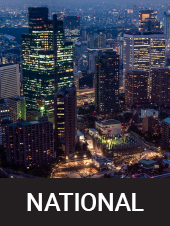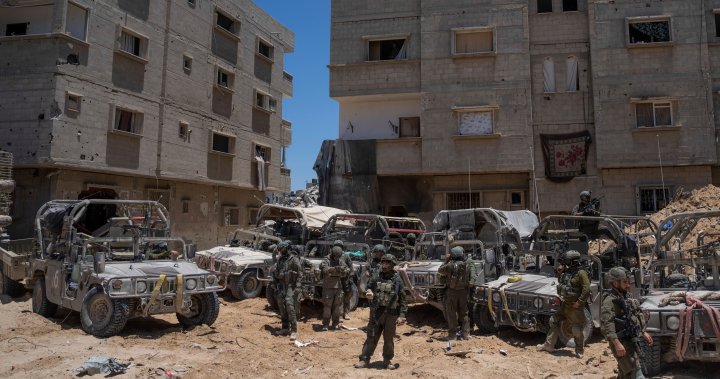Trash carried by at least one North Korean balloon fell on the South Korean presidential compound on Wednesday, raising worries about the security of key South Korean facilities during North Korean provocations.
The rubbish that landed on the presidential compound in central Seoul contained no dangerous material and no one was hurt, South Korea’s presidential security service said. While North Korea likely lacks sophisticated technology to drop balloons on specific targets, some experts say South Korea should shoot down incoming North Korean balloons next time to protect major facilities because they might contain hazardous substances in the future.
North Korean balloons are seen from the Unification Observation Post in Paju, South Korea, near the border with North Korea, South Korea, Wednesday, July 24, 2024.
AP Photo/Ahn Young-joon
North Korea’s latest balloon launches came days after South Korea boosted its broadcasts of K-pop songs and propaganda messages across the two countries’ heavily armed border. Their tit-for-tat Cold War-style campaigns are inflaming tensions, with the rivals threatening stronger steps and warning of grave consequences.
Seoul officials earlier said North Korea used the direction of winds to fly balloons toward South Korea, but some of the past balloons had timers that were likely meant to pop the bags of trash in midair.
The security service gave no further details about the rubbish found at the presidential compound. It refused to disclose whether President Yoon Suk Yeol was at the compound when the balloons were flying over his office, a no-fly zone in South Korea.
If North Korea is found to have used timers or any other device to deliberately dump trash on the presidential office, it would invite a strong response by South Korea. But experts say dropping balloons on selected ground targets requires advanced technology and that North Korea would certainly lack such an ability.
Breaking news from Canada and around the world
sent to your email, as it happens.

Get breaking National news
For news impacting Canada and around the world, sign up for breaking news alerts delivered directly to you when they happen.
“Some of (the hundreds of balloons) launched by North Korea landed on the presidential compound by coincidence. North Korea has no technology to precisely drop balloons at certain targets,” said Jung Chang Wook, head of the Korea Defense Study Forum think tank in Seoul.
Jung said that a GPS navigation device and a power system would need to be attached to a balloon to make it fall on certain sites and that North Korea doesn’t possess such balloons. He said North Korea likely wanted the balloons to fall on Seoul, about an hour’s drive from the border, after calculating factors like the weight of the trash bags tied to the balloons, the volume of air in the balloons and the weather conditions.
Lee Illwoo, an expert with the Korea Defense Network in South Korea, said strong winds in Seoul would also make it impossible for North Korea to target certain places with balloons.
South Korea’s Joint Chiefs of Staff said earlier Wednesday that North Korea had resumed floating balloons across the border, the 10th such launch since late May.
The more than 2,000 North Korean balloons discovered in South Korea in the past weeks carried wastepaper, scraps of cloth, cigarette butts and even manure. North Korea has said it was responding to South Korean activists who have scattered political leaflets across the border via their own balloons.
South Korean army soldiers wearing protective gear checks the debreis from a balloon presumably sent by North Korea, Wednesday, July 24, 2024, in Seoul, South Korea.
Park Dong-joo/Yonhap via AP
North Korea’s balloons haven’t caused any major damage but have raised security jitters among people worried it could use such balloons to drop chemical and biological agents.
South Korea has avoided shooting at the balloons because of possible damage caused by falling bullets and the chance that the balloons might contain hazardous substances.
Lee said South Korea should still shoot down North Korean balloons in border areas because attacking them over the populous Seoul area would be too risky if they contain dangerous items like biological agents. But there are worries that doing so could cause skirmishes with North Korea. Jung said South Korea could use recently developed laser weapons to intercept North Korean balloons.
Experts say North Korea considers leafleting activities by South Korean civilian groups a major threat to its efforts to stop the inflow of foreign news and maintain its authoritarian rule. In furious responses to past South Korean leafleting, North Korea destroyed an empty South Korean-built liaison office in its territory in 2020 and fired at incoming balloons in 2014.
South Korea said Sunday it was ramping up its anti-North Korean propaganda broadcasts from loudspeakers at all major sites along the land border because the North was continuing its launches of trash-carrying balloons. South Korea restarted its loudspeaker broadcasts last Thursday for the first time in about 40 days in retaliation for North Korea’s previous balloon activities.
Observers say the propaganda broadcasts can demoralize front-line North Korean troops and residents. In 2015, North Korea fired artillery rounds across the border in anger over South Korea’s restart of propaganda broadcasts, prompting the South to return fire.
South Korean Joint Chiefs of Staff spokesperson Lee Sung Joon said the current South Korean broadcasts include K-pop songs and news on South Korean economic development. South Korean media reported the broadcasts also contained news on the recent defection of a senior North Korean diplomat and called the planting of land mines by North Korean soldiers at the border “hellish, slave-like lives.”
South Korea has an estimated 40 loudspeakers — 24 stationary and 16 mobile ones. South Korea’s military said Monday it was operating all of the fixed loudspeakers and plans to use the mobile loudspeakers as well.
North Korea hasn’t officially responded to the South Korean propaganda broadcasts. But last week, Kim Yo Jong, the powerful sister of North Korean leader Kim Jong Un, threatened new countermeasures against South Korean civilian leafleting, warning that South Korean “scum” must be ready to pay “a gruesome and dear price” for their actions.
© 2024 The Canadian Press






